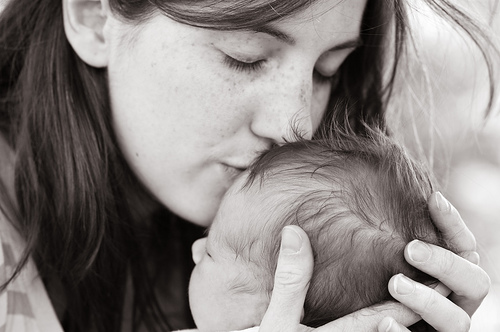Save the Children's 13th State of the World's Mothers report is out just in time for Mother's Day. The report considered multiple factors including women's health services, economic and political status, as well as child nutrition. It's interesting to take a look at the standing in different Western countries for women.
In the United States we often hear people proclaim that we live in the greatest country in the world. But do we lead when it comes to women's living and working conditions? According to the State of the World's Mothers report, no. The United States ranks 25th. Specifically, when it comes to the caring of children and financial/career ramifications of having children, it appears that the United States is lagging.
Read on for some interesting facts on a handful of countries appearing on the annual list.
Norway
Norway tops the State of the World's Mothers this year for best place in the world to be a mother, for the third year in a row.
In Norway there is 9 weeks of compulsory maternity leave, with full salary.
Three weeks of leave before and six weeks of leave after the birth of child is reserved for the mother. Ten weeks of total parental leave falls under a "paternal quota", which is reserved for the father. According to the Norwegian government website, this is to promote more men taking a greater role in care-giving responsibilities. If the father chooses not to use his quota, the weeks of leave are forfeited. Norway was the first country to enact such a scheme. In 2008, 90% of fathers used their paternal quota.
Stay-at-home Norwegian women, who do not hold jobs outside the home, are entitled to a lump sum grant when a new child is born. In 2009, it was a little over $6,000. Norwegian authorities also provide a monthly cash benefit to parents who do not enroll their children in kindergarden.
"In Norway, many more moms go back to work, partly because employers have a flexible scheme that lets workers return back to work part-time and extend their maternity leave pay up to two years," writes Christian Science Monitor correspondent Valeria Criscione, examining some of the statistics and implications of life in the Nordic country for child-rearing women. "Plus it also only costs about $400 a month for full-time day care from 7:30 a.m. to 5 p.m., summer months included."
Criscione continues, "Here, there is more pressure to have a job to go back to after maternity leave, whereas in the US you would be criticized for prioritizing your career ahead of your child’s early formative years."
Despite some continued drawbacks, it should come as no surprise that in Norway the gender gap is the narrowest in the world according to the Global Gender Gap Report.
UK
Women in the UK receive 26 weeks of "Ordinary Maternity Leave" and 26 weeks of "Additional Maternity Leave", for a combined 52 weeks. It is only mandatory, however, for women to take two weeks maternity leave after childbirth.
Some women are eligible for the Sure Start Maternity Grant, a one-time, tax-free benefit.
UK women make up half of the total workforce in their country with nearly 12 million heading to work. Family-friendly policies are seen to promote this participation.
France
Women in France are entitled to 16 weeks maternity leave (six week pre-natal, ten week post-natal), for their first two children. For women with two dependent children, maternity leave is 26 weeks (eight weeks pre-natal, 18 weeks post-natal) for the third.
New mothers must take at least eight weeks maternity leave. In accordance to law, employment is protected and the employee is not required to reveal her pregnancy until the time she intends to take maternity leave.
Paternity leave is available and begins at 11 days for a single baby, 18 days for multiples. Paternity leave must be taken consecutively and must occur within four months after the birth of a child.
Due to France's robust healthcare system, pre-and post-natal doctor appointments are comprehensive and affordable. In most cases, French women pay very little out-of-pocket for the costs of appointments and delivery. Health services for children are widely available and accessible, as each newborn is issued a "Carnet de sante de l'enfant" (infant health notebook) and mandatory appointments are eligible for reimbursement, if needed.
Canada
Female employees in Canada are allowed up to 17 weeks of unpaid maternity leave. Both mothers and fathers may take up to 37 weeks of unpaid parental leave. Mothers may combine maternity with parental leave for a total of 52 weeks of job-protected maternity leave.
There are more women employed in Canada as of 2011 than men. Equality pay is still a lingering issue, as women are only paid 71 cents to the dollar in comparison to men.
United States
The United States moved up six places this year to rank 25th place in the world to be a mother.
When it comes to the number of children enrolled in preschools or the political status of women, the United States places in the bottom 10 countries of the developed world," says Carolyn Miles, President and CEO of Save the Children.
The United States remains one of the few industrialized nations that do not provided paid maternity and/or family leave, by law. On the federal level, Family and Medical Leave Act of 1993 applies to companies with more than 50 employees. It permits 12 weeks' unpaid leave for eligible workers.
A handful of states have their own statutes, California being the first, in 2002, to enact a paid family leave act. Employees in the state may take up to 6 weeks leave while receiving up to 55% of their weekly wage. Despite some legal advances, most families use a combination of sick leave, vacation, short-term disability and unpaid leave from their jobs to cover for the birth or care of a newborn or adopted child.
Despite achieving parity in education, women continue to trail men in terms of compensation for work. In 2000, the median income for a woman with a high school diploma was $21,963, while for men it was $30,868. There are 59% of women 16 and older working in the labor force.
According to Kristin Rowe-Finkebeiner on MomsRising.org, "In fact, an enormous amount of untracked, unpaid labor done by women is fueling our economy. According to a U.N. Human Development Report, 'If these unpaid activities were treated as market transactions at the prevailing wages, they would yield huge monetary valuations — a staggering $16 trillion… Of this $16 trillion, $11 trillion is the non-monetized, ‘invisible’ contribution of women.'"

